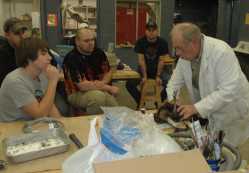The art of preservation

Hobbyists learn how to stuff game birds in taxidermy class.
By Steve Moyer
Herald-Tribune
Nevada, Mo. -- Jay Bowmaster holds a pheasant in his hands. Wires protrude from the body of the bird at the wings, tail and feet. He's preparing to show his students how to pose the bird so that it looks like a live bird in flight. The students are part of the Game Bird Taxidermy class at Nevada Regional Technical Center.
"Every one of them either harvested the birds themselves or are doing this for a friend," Bowmaster said.
The class meets weekly for seven or eight weeks, and during that time the students can do two birds, one in a standing pose and one in a flying pose.
"I taught this for two years several years ago," Bowmaster said. "There aren't really enough people interested to do this every year, but we might do it next year and then wait another few years before offering it again."
Bowmaster has some specialized supplies he can sell the students but some supplies can come from local stores, depending on the type of animal being mounted.
"Birds don't require any chemicals except borax -- Twenty Mule Team Borax," Bowmaster said. "Doing your own mounting costs very little, $6 or $7. You can get everything you need from stores around Nevada," The bird is skinned, then the taxidermist scrapes all the fat and meat from the skin, then washes and dries it before moving on to the final step of mounting it permanently.
Other chemicals are needed for some types of taxidermy.
"Birds, mammals and fish are all different," Bowmaster said. "There are some chemicals needed for mammals."
Taxidermy has evolved over the years from the first crudely stuffed animal skins that produced ugly, artificial-looking artifacts to today's very life-like looking mounts. Today a taxidermist can start with an artificial body made from Styrofoam with a fiberglass coating and use foam and other inexpensive material to form the foundation upon which the skin of the bird will ultimately be mounted.
"You use wire, tape and cardboard to keep the wings in place while it dries," Bowmaster said. "Once it dries it stays in place on its own."
Bowmaster said that many of his students delve into taxidermy for their own pleasure, but some have gone into business.
"It's an inexpensive hobby and most do it just for that," Bowmaster said. "I have had some go into the field and it can be a profitable business."
